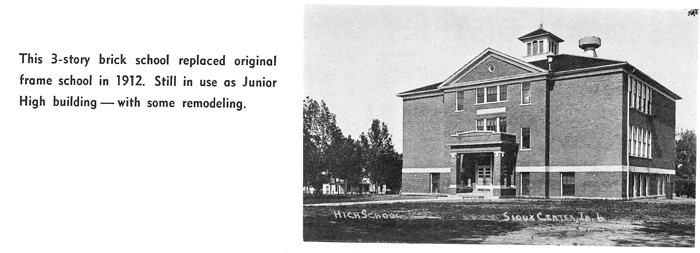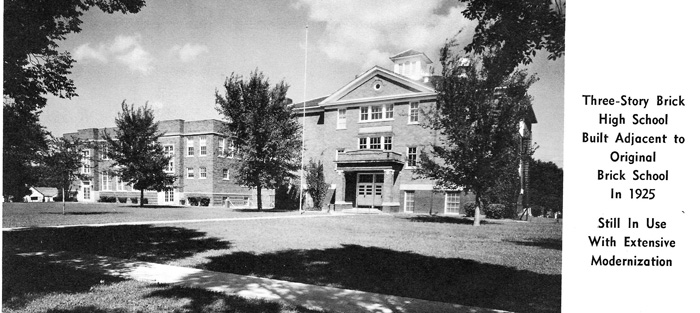Sioux Center’s first 75 years 1891-1966 Pages 35 – 39
SCHOOL DISTRICT ORGANIZED IN 1891
The Sioux Center Community School
The Sioux Center Independent School District as organized in 1891. Henry Wayenberg, W. F. Nieland, R. Borgman, and Peter Egan served on the first board of education .
The first frame school was built during the summer of 1891 at a cost of $3,000. Classes convened in the fall. Mrs. A. D. Hayes was the first principal his salary was 60 dollars per month. His assistant was Miss Alice Yokie, who earned 40 dollars per month. The school term for the school’s eight grades was only seven months long.
In 1896 two rooms were added to the school The same year, the free text book program, the first in Sioux County , was adopted. ( The free text book program is still employed by the city’s public schools.) cont. on page 36..
In 1897 the 9th and 10th grades were added to the curriculum, and two additional teachers were hired. The first students to be graduated from the 10th grade were John F. D. Aue, George Siemen, Joe Spinden, Jacob Vander Zee,D. H. Wissink, and Johanna Mouw. One of these graduates, Dacob Vander Zee, later won renown in the field of education. After completing his high school education at Northwestern Classical Academy in Orange City, he attended the University of Iowa where he was awarded a Rhodes Scholarship to study in London, he joined the facility at the University of Iowa.
In 1900 the 11th and 12th grades were added to the school program. The first students to be graduated from the 12th grade were Edward Siemen and Lena Mouw. In 1910 the Sioux Center High school became fully accredited.
When a bond issue for $25,000 was approved in 1912, the frame school was torn down and a larger brick school was built. The additional space made it possible to add, in 1913, a home economics department and a normal training program. Normal training qualified high school graduates to teach the first eight grades. Many students enrolled in the program and later taught in the rural schools around Sioux Center. In 1915 Miss Frances Hawkinson became the school’s first fulltime vocal music teacher.
By 1925 the school was again overcrowded. A bond issue for $45,000 was approved and a brick high school was built north of the 1912 building, which then became the grade and junior high school. The new high school building had two important new features – an auditorium – gymnasium, the first in Sioux Center, and a music room.
In 1926 the school for the first time entered a vocal group in the State Music Contest in Iowa City. The male quartet (James Wandscheer, first tenor, John Wesselink, second tenor, Benjamin Vermeer, baritone, and Joe Wandscheer, bass) won a first rating. This achievement encouraged even greater participation in the school’s music activities.
Prior to 1945 the school provided no bus service and there were no provisions for a school district to purchase buses. Although most rural children attended rural grade schools, those rural children who later wished to attend the high school in town faced the problem of transportation. (At that time the township from which the student came, paid his tuition to the Sioux Center district) Because rural parents found it a nuisance to drive to and from school each day, many of them bought old cars for their children. Students driving these cars around town before and after school hours created a problem for the town.
The transportation problem was solved in 1945 when Bernard Ver Hoef of the Ver Hoef Chevrolet Company made an agreement with the Sioux Center Independent School District to purchase three School buses and to operate three routes for rural students. The agreement stipulated that the state pay one-half of the bus fare for each child and that the parents pay the other half. Mr. Ver Hoef signed contracts with parents to drive their children and, with the help of Eugene Kuyper, provided bus service for the entire district. (The boundaries for the school district which were set up at that time have changed very little through the present time. ) Several rural students who attended other high schools in the area transferred to the Sioux Center High School because of the bus service – the first to be offered in the county. (Today the school system operates fourteen buses for rural and urban students.)
The school’s enrollment continued to grow, and within the next few years manual training and vocational agriculture were added to the high school curriculum. A vocational agriculture building was erected two blocks west of the school and a good garage building a half block west of the school was remodeled into three classrooms. These buildings are still is use at the present time.
By 1952 it was clear that the auditorium-gymnasium was no longer adequate. The gym could not accommodate the crowds attending school programs and ballgames, and the playing floor was too small. A bond issue for $200,000 was approved, and by 1955 the present auditorium – gymnasium, with a seating capacity of 2200, was completed. It was used not only for school functions, but also for community affairs and Dordt College activities.
In 1958 when the school reorganization program was put into effect in Sioux County, the Sioux center Independent School district became the Sioux Center Community School District. The boundaries of the original district were changed only slightly. At present, Sioux Center remains the only city in its school district and covers its surrounding territory very well.
In 1959 both schools were remodeled to keep pace with changes in school curriculum. One important change was the addition of a library room.
In 1961 the Kinsey Grade School with twelve classrooms, kitchen, lunch room, and principal’s office was built in the southern part of the city. Three years later a twelve-classroom addition was added to the Kinsey School. The same year the two older schools were once again remodeled.
Sioux Center’s present public school system offers a comprehensive curriculum, a wealth of extracurricular activities, and more than adequate facilities for the education of young people |





